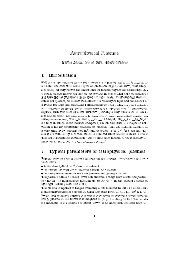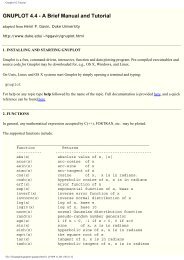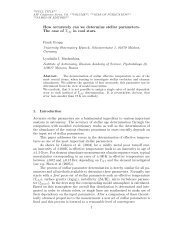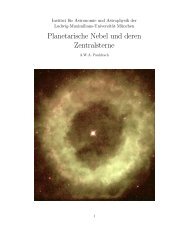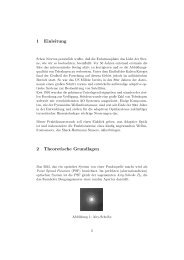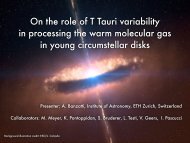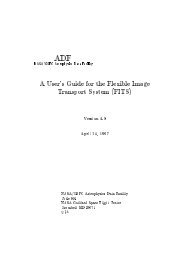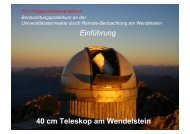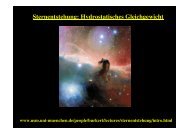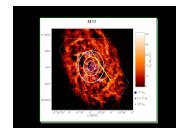VIRUS: a hugely replicated integral field spectrograph for HETDEX
VIRUS: a hugely replicated integral field spectrograph for HETDEX
VIRUS: a hugely replicated integral field spectrograph for HETDEX
Create successful ePaper yourself
Turn your PDF publications into a flip-book with our unique Google optimized e-Paper software.
<strong>VIRUS</strong>: a <strong>hugely</strong> <strong>replicated</strong> <strong>integral</strong> <strong>field</strong><strong>spectrograph</strong> <strong>for</strong> <strong>HETDEX</strong> 1Gary J. Hill a,2 Phillip J. MacQueen a Povilas Palunas aAndreas Kelz b Martin M. Roth b Karl Gebhardt aFrank Grupp ca McDonald Observatory & Department of Astronomy, University of Texas atAustin, 1 University Station, Austin, TX78712, USAb Astrophysikalisches Institut Potsdam (AIP), An der Sternwarte 16, D-14482Potsdam, Germanyc Universitaets-Sternwarte (USM), Scheinerstrasse 1, D-81679 Munich, GermanyAbstractWe present the Visible Integral-<strong>field</strong> Replicable Unit Spectrograph (<strong>VIRUS</strong>),the basis of the Hobby-Eberly Telescope Dark Energy Experiment (<strong>HETDEX</strong>); asurvey of a 5 Gpc 3 volume at 1.8 < z < 3.7 that will constrain the evolution ofdark energy. <strong>VIRUS</strong> consists of 145 copies of a simple unit <strong>spectrograph</strong>, deployedon the HET. Industrial replication will allow <strong>VIRUS</strong> to be built quickly, at considerablecost-savings, with substantial risk-mitigation, compared to conventionalinstruments. <strong>VIRUS</strong> will cover 30 sq. arcmin. per observation and detect 14 millionresolution elements per exposure, an order of magnitude larger than existinginstruments. <strong>VIRUS</strong> can complete <strong>HETDEX</strong> in about 100 nights observing.Key words: instrumentation: <strong>spectrograph</strong>s (<strong>VIRUS</strong>); surveys (<strong>HETDEX</strong>);cosmological parameters; large-scale structure of UniverseScience Motivation: Large, targeted surveys of continuum selected objectsare now becoming the norm, and have greatly increased our understanding inmany areas of astronomy. Surveys of the emission-line universe, however, arelimited currently to wide <strong>field</strong> imaging with narrow band filters or to narrower<strong>field</strong>s with Fabry-Perot etalons. Integral <strong>field</strong> (IF) <strong>spectrograph</strong>s offer a huge1 <strong>HETDEX</strong> is led by the University of Texas at Austin with participation from theUniversitäts-Sternwarte München, the Max-Planck-Institut für Extraterrestriche-Physik, and the HET consortium. http://www.as.utexas.edu/hetdex/2 correspondance to GJH: hill@astro.as.utexas.eduPreprint submitted to Elsevier Science 18 August 2005
Table 1Basic Properties of <strong>VIRUS</strong>IFUCollimatorCameraDisperser246 fibers, each 200 µm dia. or 1.0 sq. arcsec. areasquare <strong>for</strong>mat 29 x 29 arcsec 2 , 1/3 fill-factor, hexagonal packfed at f/3.65 at prime focus of HETaccepts f/3.35, reverse Schmidt reflective designf/1.33 Schmidt with 2k x 2k 15 µm pxl CCD at internal focusVPH grating gives 340-570 nm simultaneous coverage at R∼850The <strong>VIRUS</strong> Spectrograph and Integral Field Unit: A detailed descriptionof the <strong>VIRUS</strong> opto-mechanical design will be given elsewhere, but isdiscussed in (5), and summarized in Table 1. Here we concentrate on the IFUdesign. It is essential to couple <strong>VIRUS</strong> to the HET with fibers due to theweight and space constraints at the prime focus of the telescope. In addition,the variable effects of the changing pupil illumination of HET during atrack are mostly removed by radial scrambling along a fiber, producing muchgreater stability in the data calibration than is possible with an imaging <strong>spectrograph</strong>.HET has a fast focal ratio in order to couple efficiently to fibers,and <strong>VIRUS</strong> will use a densepak-type IFU (2). The layout of the fibers is in ahexagonal pack with a 1/3 fill-factor. This is most optimal <strong>for</strong> covering area,since a dither-pattern of three exposures exactly fills the <strong>field</strong> of the IFU,while maximizing the area covered per IFU. Lenslet-coupled fiber IFUs havethe principal advantages of providing contiguous coverage of a small <strong>field</strong>, andallowing the slow f-ratio beams of large telescopes to be coupled efficiently tofibers. However, lenslets suffer from significant inefficiencies in the couplingbetween the micro-pupils created by the lenslets and the fibers, due to lensquality and diffraction effects (8). If the fiber core is oversized to mitigatethese effects, then resolution is lost (5; 8). For fibers fed at the same f-ratio,the bare bundle will cover the same area of sky in three exposures as does alenslet system, but offers significantly higher overall throughput (5).The design of the IFU follows experience with the PPAK bundle (7), andinitial tests are reported in (3). The 1/3 packing fraction at the IFU input isnot naturally achieved with polyamide-buffered fiber, and softer buffer materialsdo not polish well, so we have investigated two approaches to establishthe spacing. In the first, a matrix of thin-walled fused silica capillary tubingwith appropriate inner and outer diameters (Polymicro TSP250350 250 µmID, 360 µm OD, polyamide coated) is set up in a precision <strong>for</strong>m, and thenpopulated with Polymicro FBP200220240 fiber that has 240 µm nominal OD.In the second approach, precision holes of 0.25 mm diameter are drilled in aplastic plate, where the fiber is inserted. Both approaches have been successfulin creating spacings with better than 4 µm rms error in the pitch. Manualthreading of the fiber into these matrices is remarkably easy, though handling3
Fig. 1. Two methods <strong>for</strong> constructing the IFU head input with 1/3 fill factor. Atleft, fibers are threaded into a matrix of thin-walled fused silica capillary. At rightthey are threaded into a plastic disk precision-drilled with 0.25 mm holes. Bothmethods create a bundle of high quality with 4 µm rms position errors.35,000 fibers will be a challenge. Once loaded with fiber, the head assemblyis immersed in EPOTEK 301-2 low-shrinkage epoxy, which wicks up betweenthe fibers. In the case of the capillary tubes, we find very uni<strong>for</strong>m capillaryaction which fills the 5 µm radial clearance between the fiber and the ID of thetube (Fig 1 left panel). Following cure, the fibers are trimmed with a diamondsample saw and polished. The input end is immersed against an AR coatedglass plate to improve coupling.At the output of the fiber bundle, each of the 17 rows of the IFU layout isbonded to a slitlet, that is mounted within the IFU slit frame. The simpledesign of the <strong>VIRUS</strong> collimator, based on a Schmidt camera, requires thatthe fibers each aim normal to the spherical collimator mirror, and to facilitatethis they are immersed against a cylindrical lens, with the axes of the slitletsnormal to the concave surface of the lens. Within each slitlet, the fibers mustalso be angled so that their pupils coincide, and light-loss is minimized. This isachieved by machining precision grooves in the stainless steel slitlet substratewith accurate tilts between them. The fiber is then glued to the substrateswith low shrinkage epoxy, as is normal practice. In tests, the FRD appearsvery similar between single fibers and each of the fiber head designs, with thecapillary tube-based design showing the best uni<strong>for</strong>mity in early tests. We areassembling bundles of each design <strong>for</strong> delivery at the end of the year.<strong>VIRUS</strong> on HET: <strong>HETDEX</strong> demands the largest area coverage, but doesnot require a high fill-factor <strong>for</strong> the IFUs within the <strong>field</strong> (6). The 20 arcmindiameter <strong>field</strong> of the new HET corrector will be covered by 145 IFUs with∼1/9 fill-factor. This is 35,670 fibers, and >14 million resolution elements perexposure. Each observation of 3 dithered exposures will observe 30 sq. arcmin.area within the 250 sq. arcmin. HET <strong>field</strong>. Estimates show a line flux limit of1-2e-17 erg/cm 2 /s in two 180s exposures per dither position. This observingsequence can be achieved in 20 minutes per <strong>field</strong> including setup time.4
Fig. 2. Images of slitlet substrate during assembly. The left image shows the 15fibers layed in the grooves of the stainless steel substrate, prior to bonding. Thegrooves radiate with an angle of 0.044 deg. with respect to one another. On theright is part of the illuminated bundle following polishing. The projected size andpitch of the fibers are indicated. Simulations show that the excellent image qualityof the <strong>VIRUS</strong> optics allows clean separation of the spectra from individual fibers.The prototype <strong>VIRUS</strong> unit <strong>spectrograph</strong> will enter use in early 2006. Costingand design <strong>for</strong> the <strong>replicated</strong> instrument will be developed from the prototype,while it is used to per<strong>for</strong>m a wide-<strong>field</strong> pilot survey <strong>for</strong> LAEs. With fundingin 2006, we expect to deploy the full <strong>VIRUS</strong> in late 2008, and to complete<strong>HETDEX</strong> in 2011.Acknowledgements The <strong>VIRUS</strong> prototype is funded by the George andCynthia Mitchell Foundation. Partial funding <strong>for</strong> <strong>HETDEX</strong> is provided byAFRL under agreement number FA9451-04-2-0355. The support of RepresentativeHenry Bonilla and David Lambert is gratefully acknowledged. Wethank F. Cobos and C. Tejada (Instituto de Astronomía, UNAM), <strong>for</strong> importantcontributions to the optical design of <strong>VIRUS</strong>. We thank S.-M. Bauer, R.Bender, J. Booth, N. Drory, C. Goessl, J. Good, U. Hopp, E. Komatsu, E.Popow, P. Schücker, G. Wesley, and Polymicro Technologies.References[1] R. Bacon et al., Proc. SPIE 5492 (2004) 1145[2] S.C. Barden, R.A. Wade, ASP Conf. Ser. 3 (1988) 113[3] F. Grupp (2005) these proceedings[4] G.J. Hill, P.J. MacQueen, Proc. SPIE 4836 (2002) 306[5] G.J. Hill, P.J. MacQueen, C. Tejada, F.J. Cobos, P. Palunas, K. Gebhardt,N. Drory, Proc. SPIE 5492 (2004) 251[6] G.J. Hill, K. Gebhardt, E. Komatsu, P.J. MacQueen, The Mitchell Symposiumon Observational Cosmology, AIP Conf. Proc. 743 (2004) 224[7] A. Kelz, et al. Proc. SPIE 5492 (2004) 719[8] e.g. I. Parry, (2005) these proceedings5






